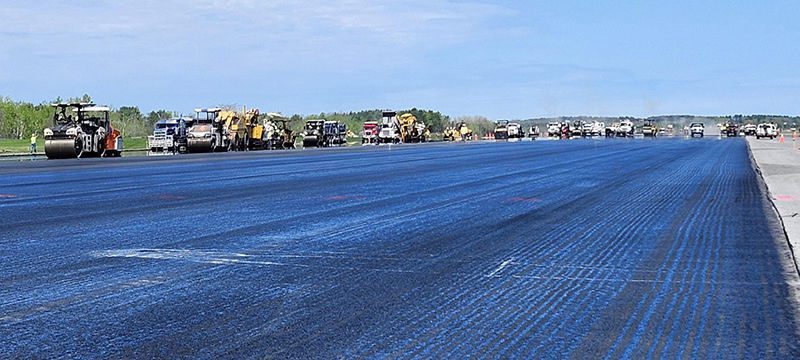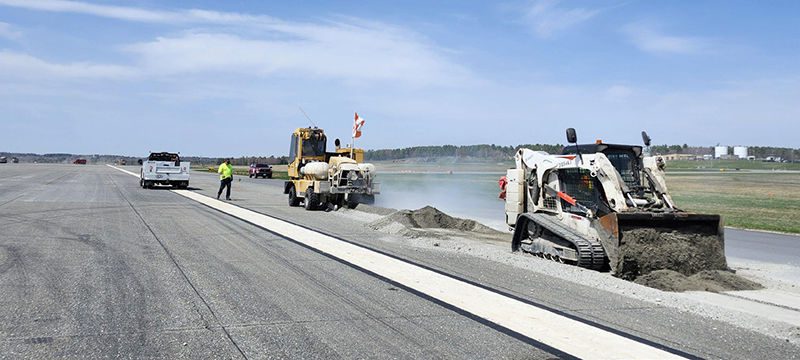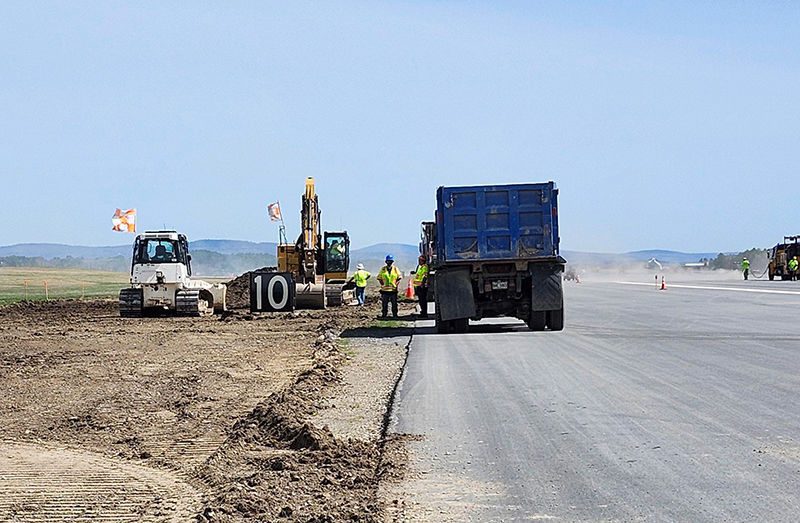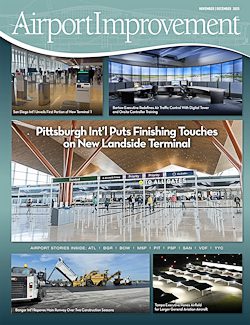Located on the northeastern U.S. seaboard, Bangor International Airport (BGR) in Maine serves a special role in the National Airspace System and larger international network. In addition to accommodating everyday commercial, general aviation and military traffic, BGR is the closest U.S. port-of-entry from Europe and a popular option for routine transatlantic stops. It is also often the first available place to land when overseas flights bound for New York or Boston encounter unexpected maintenance issues, onboard medical emergencies, unruly passengers, ground stops at other East Coast airports and other nonstandard situations.
 “We like to call ourselves the Capital of Diversion,” says Airport Director Jose Saavedra.
“We like to call ourselves the Capital of Diversion,” says Airport Director Jose Saavedra.
That special role raised the stakes when BGR’s 11,440-foot sole runway needed to be resurfaced. To keep air traffic flowing and take into account local weather that limits paving when temperatures begin to drop, the airport split its runway improvement project between two separate construction seasons.
Work began in May 2024 on the north end and included half of the middle section. “By doing this, we still had 7,300 feet of open runway,” Saavedra explains. “That was long enough to accommodate most of our customers.”
| facts&figures
Project: Runway Improvements Location: Bangor Int’l Airport, in ME Runway: 15-33 Scope: Repaving entire 11,440 ft. asphalt runway; installing new LED lights for centerline & touchdown zone Cost: $50 million Funding: 60% FAA Grants; 35% National Guard; 2.5% state; 2.5% local Engineering Consultant: Jacobs Chief Contractor: Eurovia Electrical: Moulison Runway Markings: Sawing & Sealing: Indus Grooving & Grinding: Cardinal Int’l Surveying: Plisga & Day Lighting Manufacturer: Key Benefits: Improved airfield safety & efficiency; increased longevity of runway |
Crews finished the first paving portion on Sept. 18, 2024, before the weather turned too wet or cold. Construction on the south end and other half of the middle section was then completed this year. The airport opened Runway 15-33 in September at full length, with remaining electrical installations and other touch-up work wrapping up in mid-October.
Funding for the $50 million project was provided by several sources: 60% from the FAA; 35% from the Maine National Guard (a key tenant/airport user); 2.5% from the state of Maine; and 2.5% from local funds.
False Start
When Saavedra took over as airport director in November 2023, planning for the project was well underway. It had occurred before Tony Caruso retired as airport director earlier that year, but the overall effort was hampered by the COVID-19 epidemic. After the original request for proposals was sent out, the airport only received one bid, and it was twice the amount that had been estimated. “At that point, it was too late to start construction, so we had to start over,” explains Saavedra.
One of his first primary responsibilities after arriving at BGR was to study and revise the bid documents. “In January 2024, we advertised again, and sent out a new RFP,” he recalls. “We received a new bid in March 2024, and awarded the contract to Eurovia in April 2024.”
Losing a full year of progress made some stakeholders skeptical about the project overall. So Saavedra and his team spent the beginning of 2024 reassuring all airport stakeholders that the repaving project was fully funded and on schedule to begin that May. “Since we were already a year behind the original schedule, we had lost the confidence of some of them, and had to rebuild trust,” Saavedra explains. “For example, some of the commercial airlines had to pull their schedule and cancel flights, so they weren’t happy with us. Therefore, we knew we really had to improve our communication with the stakeholders.”
Restoring Confidence
The airport worked with Jacobs, the project engineer, to host several weekly meetings before and during construction. Usually, 50 to 80 participants attended.
“Fortunately, things went well in our first year, and we stayed on schedule. We eventually got their trust back,” Saavedra says of the stakeholders.

The second year of construction also finished on time. Overseeing day-to-day operations for the runway work was Matt Montgomery, a Eurovia project superintendent based in nearby Hermon, ME. Montgomery organized and scheduled each step of the two-year endeavor, and supervised the chief contractor’s team of approximately 60 workers.
One of his key responsibilities was coordinating with the Maine Air National Guard, which operates the 101st Air Refueling Wing out of its base at BGR. Throughout the year, Guard personnel hold training exercises during the day and at night. “But during construction, they were very good at keeping us informed of their training schedules, in which several aircraft would be in the air at the same time,” Montgomery notes.
Repaving the middle section of the runway—about 2,500 feet during each construction season—was especially challenging. “During that work, the whole runway was closed for 55 hours at a time, so the work had to be done overnight,” Montgomery relates. “Generally, this closure period ran from 8 a.m. Monday until 3 p.m. Wednesday. Besides repaving, we had to do all electrical work, coring and soft cutting.
“We were lucky on the weather,” he adds. “We had some rain, but nothing we could not handle.”
During the first few months of construction, asphalt was supplied by three different local sources, but by July 2024, all of the paving material came from a new plant Eurovia built in Hermon, just five miles from the airfield. With production rates of up to 500 tons an hour, the plant made paving operations more efficient going forward. The particular asphalt used for the project was a high-end polymer mix that Montgomery explains was well suited for Bangor’s ever-changing weather conditions.

When new asphalt was still wet, crews cut in grooves to enhance traction.
Electrical crews replaced all wiring for the edge lights and centerline lights and routed it to the existing electrical vault. In addition, some lights were upgraded with new LED fixtures. The touchdown lights were replaced in 2024, and the centerline lights were switched out in late summer and early fall, 2025.
To prevent operational disruptions, BGR only allowed electrical work on the airfield from midnight to 5 a.m. “It was necessary to get our people and trucks in place to start the electrical work right at midnight,” says Montgomery.
One of the final steps was cutting grooves into the fresh asphalt to enhance traction when the pavement is wet. During this step, crews ran into a minor complication when the slurry pond they were originally using did not meet environmental regulations. “We had to find another site that was larger and on higher ground,” Montgomery explains. “That was no big deal.”

Crews cut the concrete to place conduit that carries new wiring for runway lights.
Diverse Client Base
With its distinct blend of commercial, general aviation, cargo and military traffic, BGR logged about 40,000 flight operations last year. Commercial service is provided by Allegiant Air, American Airlines, Breeze Airways, Delta Air Lines and United Airlines.
Besides housing the Maine Air National Guard, the airfield also serves other military organizations. “We have a strong military presence from both here and abroad,” Saavedra says. “We often host pilots from Belgium, Israel and Germany who train here. In addition, aircraft from the Navy and Marines frequently land here for brief stopovers.”
Diversions, especially from airliners returning to North America after flying over the Atlantic Ocean, are a regular occurrence. And the airport is well equipped to handle these unexpected guests. “We have a nice international terminal. Customs regional headquarters is on-site here, so we can clear any type of aircraft,” says Saavedra. “We also have 1,100 feet of extra space that can be used for parking planes.”

The project included earthwork in the runway safety area.
Due to the diverse mix of traffic, there is a consistently strong demand for fuel. The airport owns and operates its own fixed-base operator (BGR Aviation), complete with a 3-million-gallon fuel farm. In fact, fuel sales comprise one-third to one-half of total revenue. “We sell 20 to 25 million gallons of fuel a year,” Saavedra reports. “If I added up other services provided by our FBO, I would estimate that between 50% to 75% of our overall revenue comes from BGR Aviation.”
Obvious Improvements
When Runway 15-33 recently reopened at its full length of 11,440 feet, military, commercial, cargo and general aviation aircraft operating at BGR essentially had a new runway. Between the fresh asphalt surface and new LED lights along the centerline and touchdown zones, the difference was immediately evident, Saavadra reports.
“The pilots I have talked to were very complimentary,” he says. “We are very proud of what we accomplished.”
Looking ahead to even more improvements, the airport is currently working on a TSA checkpoint expansion, the rehabilitation of its parallel taxiway and a consolidated car rental facility.



